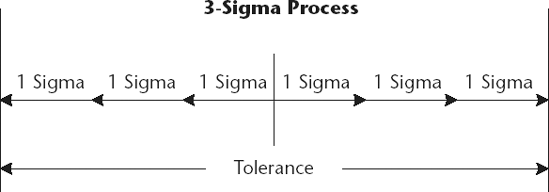1.2. SIGMA
One of the ways to measure the variation of a product or a process is to use a mathematical term called sigma. We will learn more about sigma and how to calculate this value as we proceed, but for now it is enough to know that the lower the sigma value, the smaller the amount of process variation and the higher this sigma value, the greater the amount of the process's variation. Since the sigma calculation is normally done on a computer or calculator, it is more important that you gain a sense that sigma is a measure of the data spread (variation) than it is to be too involved with the detailed actual calculation of sigma.
Ideally, the sigma value is low in comparison with the allowable tolerance on a part or process. If so, the process variation will be small compared with the part or product tolerance a customer requires. When this is the case, the process is "tight" enough that, even if the process is somewhat off-center, the process produces product well within the customer's needs and specifications.
Most companies have processes with a relatively large variation compared with their customers' needs (a relatively high sigma value compared with the allowable tolerance). These companies run at an average ±3-sigma level (a 3-sigma process). This means that 6 sigma (±3 sigma) fit between the tolerance limits. The more sigma that fit between the tolerance limits, the better.
Figure 1-2. ±3 Sigma

Sigma level is calculated by dividing the process's allowable tolerance (upper specification minus lower specification) by twice the process's sigma value, since the sigma level of a process is normally stated as a ± value.
NOTE
Process Sigma Level
As an example, suppose a process machining shafts has the following measurements:
Sigma = 0.001"
Maximum allowable shaft diameter = 1.003"
Minimum allowable shaft diameter = 0.997"
So, the tolerance = 1.003" - 0.997" = 0.006"
We put these values into the above formula:

So, this process is running at ± 3 sigma or, in the terms of Six Sigma, this is a 3-sigma process.
As you will see later in the book, a ±3-sigma process generates 99.73% good product, or 997,300 good parts out of every 1,000,000 parts produced. This means that there are 2700 defective parts out of every 1,000,000 parts produced (or 2700 input errors per 1,000,000 computer entries, etc.). These defects are very costly, causing scrap, rework, returns, and loss of customers. Eliminating this lost product has the potential to be a very profitable "hidden factory," because all the costs and efforts have been put into the defective product, but it's unusable.
Some companies, like aircraft manufacturers, attempt to run very critical parts at a 7-sigma level. This means that the variation is so low that ±7-sigma fit between the specification high/low limits. This targeted extremely low defect level (low process variation vs. the allowable tolerance) is sought due to the catastrophic potential of a defect (a part being outside tolerance).
A Six Sigma process runs with a variation such that ±6 sigma (including some process drift), or 12 sigma, fit within the tolerance limits. This will generate three defects per million parts produced. This was the original quality goal of this methodology and it's how the name "Six Sigma" became associated with this methodology. This extremely low defect incidence is not required in most real-world situations and the cost of getting to that quality level is usually not justified. However, getting the quality to the level where the customer is extremely happy and supplier losses are very low is generally a cost-effective goal.
Companies that embrace the Six Sigma philosophy train people to various skill and responsibility levels and assign the following titles.
NOTE
Green Belt
A Six Sigma green belt is the primary implementer of the Six Sigma methodology. He or she earns this title by taking classes in Six Sigma, demonstrating a competence on Six Sigma tests, and implementing projects using the Six Sigma tools.
Black Belt
A Six Sigma black belt has Six Sigma skills sufficient to act as an instructor, mentor, and expert to green belts. A black belt is also competent in additional Six Sigma tool-specific software programs and statistics.
Master Black Belt
A Six Sigma master black belt generally has management responsibility for the Six Sigma organization. This could include setting up training, measuring its effectiveness, coordinating efforts with the rest of the organization, and managing the Six Sigma people (when Six Sigma is set up as a separate organization).
Much of Six Sigma is not new. The Six Sigma methodology includes elements from SPC (statistical process control), the scientific method of problem solving, and procedures to incorporate expert knowledge. Practical application of statistics and probability is inherent in the Six Sigma process. However, the Six Sigma methodology brings all these elements together in a synergistic and disciplined fashion that has proven to be effective in driving process improvement. The use of Six Sigma doesn't change someone's job; it just makes him or her more effective in doing that job.
